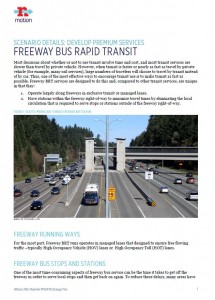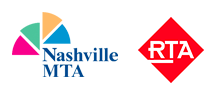This report in the Transit Strategies Series explores freeway bus services. Freeway bus services operate along freeways, either in regular traffic lanes, in high-occupancy vehicle (HOV) lanes, or along the shoulders. Freeway bus services also have stations within the freeway right-of-way to minimize travel times by eliminating all or most of the local circulation that is required to serve stops or stations off the freeway.
What do you think? Where should Nashville MTA/RTA consider freeway bus rapid transit?


As described in the article, the BRT system will likely increase congestion on I65 instead of alleviate it because buses lack the rider capacity, even with high frequency routes, to offset the current automobile carrying capacity of the 2 HOV lanes this system will cannibalize. Unlike commuter trains which can be configured with extra cars during peak usage and fewer during off peak time, buses have fixed capacities (and relatively lower reliability) and as a result properly configured trains will always have greater peak usage capacity over a given time interval. Moreover since commuters appear to prefer trains to buses demand for train usage will likely be greater than demand for BRT usage. For these reasons, I’m doubtful that a BRT system would improve current commute times let alone commute times in the future.
While surely more expensive to build, the better long term mass transit system along I65 is a 2 track, elevated light rail built straight down the middle of the interstate. This system would preserve the traffic lanes currently designated as HOV, add flexible capacity, high speed, high reliability mass transit where none currently exists, and satisfy riders putative demand preferences. Let’s not be short sighted and build the wrong system just to build something now.
The Freeway BRT routes described for Scenario 1 (at least out to Franklin) is what I had hoped/imagined would be the Light Rail system that would serve as the high-speed backbone of a future regional transit network. It would be very fast and very high capacity, also a very desirable alternative for suburban commuters. People I talk to say they would give up their cars if transit were faster.
The Freeway BRT document talks about peak period service of up to eight buses per hour in either a dedicated or HOV lane. That certainly doesn’t sound anywhere near enough for a dedicated lane. HOV lanes are not enforced (commuters dread HOV enforcement) and the rules allow motorcycles, hybrids and idiots who use the HOV lane to stop all five lanes of interstate to exit.
Here is what I perceive to be the difference between Freeway BRT and Light Rail: Light Rail could eventually carry enough commuters to justify using a dedicated freeway lane.